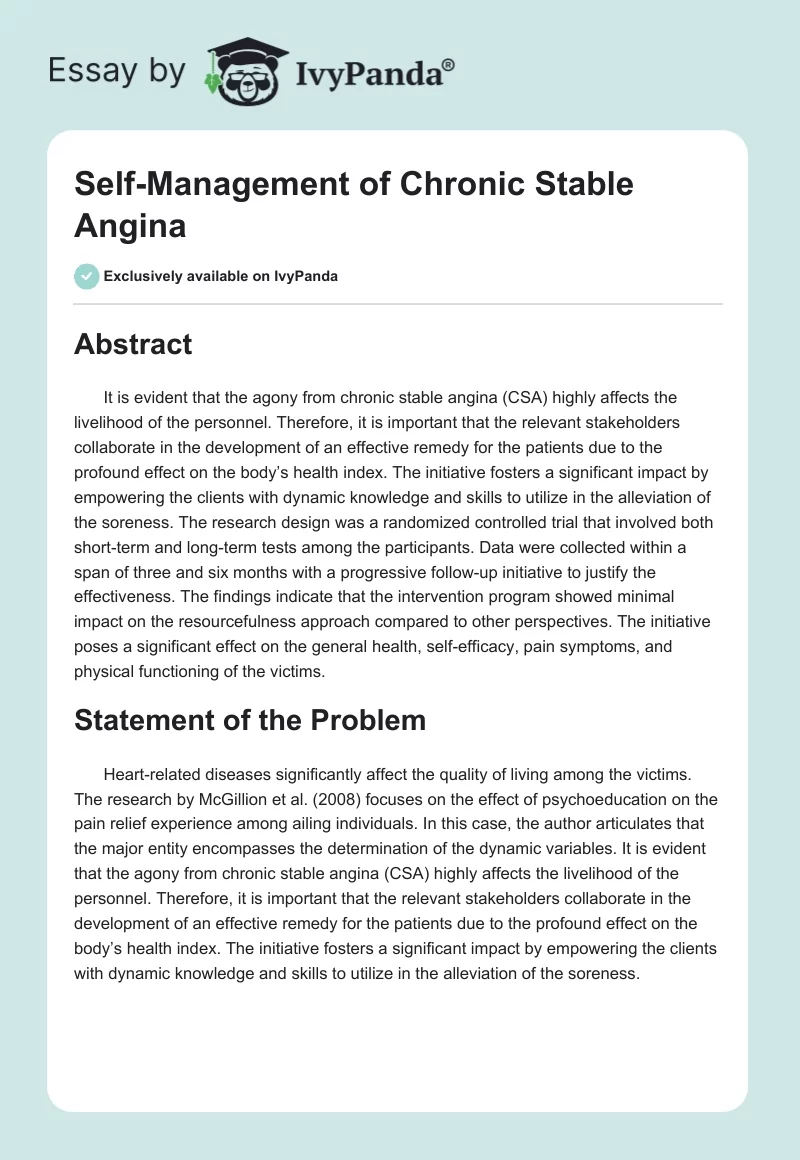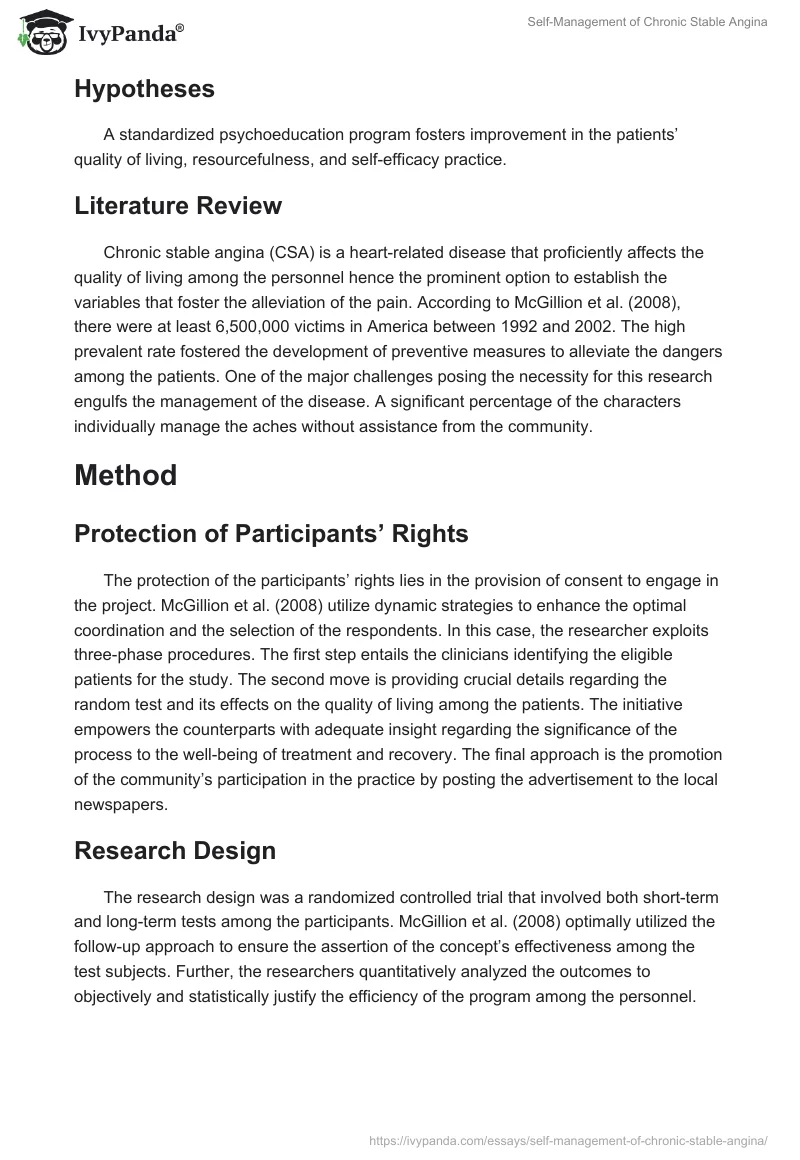Abstract
It is evident that the agony from chronic stable angina (CSA) highly affects the livelihood of the personnel. Therefore, it is important that the relevant stakeholders collaborate in the development of an effective remedy for the patients due to the profound effect on the body’s health index. The initiative fosters a significant impact by empowering the clients with dynamic knowledge and skills to utilize in the alleviation of the soreness. The research design was a randomized controlled trial that involved both short-term and long-term tests among the participants. Data were collected within a span of three and six months with a progressive follow-up initiative to justify the effectiveness. The findings indicate that the intervention program showed minimal impact on the resourcefulness approach compared to other perspectives. The initiative poses a significant effect on the general health, self-efficacy, pain symptoms, and physical functioning of the victims.
Statement of the Problem
Heart-related diseases significantly affect the quality of living among the victims. The research by McGillion et al. (2008) focuses on the effect of psychoeducation on the pain relief experience among ailing individuals. In this case, the author articulates that the major entity encompasses the determination of the dynamic variables. It is evident that the agony from chronic stable angina (CSA) highly affects the livelihood of the personnel. Therefore, it is important that the relevant stakeholders collaborate in the development of an effective remedy for the patients due to the profound effect on the body’s health index. The initiative fosters a significant impact by empowering the clients with dynamic knowledge and skills to utilize in the alleviation of the soreness.
Hypotheses
A standardized psychoeducation program fosters improvement in the patients’ quality of living, resourcefulness, and self-efficacy practice.
Literature Review
Chronic stable angina (CSA) is a heart-related disease that proficiently affects the quality of living among the personnel hence the prominent option to establish the variables that foster the alleviation of the pain. According to McGillion et al. (2008), there were at least 6,500,000 victims in America between 1992 and 2002. The high prevalent rate fostered the development of preventive measures to alleviate the dangers among the patients. One of the major challenges posing the necessity for this research engulfs the management of the disease. A significant percentage of the characters individually manage the aches without assistance from the community.
Method
Protection of Participants’ Rights
The protection of the participants’ rights lies in the provision of consent to engage in the project. McGillion et al. (2008) utilize dynamic strategies to enhance the optimal coordination and the selection of the respondents. In this case, the researcher exploits three-phase procedures. The first step entails the clinicians identifying the eligible patients for the study. The second move is providing crucial details regarding the random test and its effects on the quality of living among the patients. The initiative empowers the counterparts with adequate insight regarding the significance of the process to the well-being of treatment and recovery. The final approach is the promotion of the community’s participation in the practice by posting the advertisement to the local newspapers.
Research Design
The research design was a randomized controlled trial that involved both short-term and long-term tests among the participants. McGillion et al. (2008) optimally utilized the follow-up approach to ensure the assertion of the concept’s effectiveness among the test subjects. Further, the researchers quantitatively analyzed the outcomes to objectively and statistically justify the efficiency of the program among the personnel.
Population and Sample
The sample population that participated in the randomized trial involved 117 individuals whose mean age was 68 years old. There was a distinct gender ratio due to the 80% composition of males and 20% females. McGillion et al. (2008) focus the study among people victimized by heart-related disease to understand the effectiveness of the intervention program. The sample size was adequate based on the dynamic exposure to the observational approach among the counterparts. In this case, the snippet is based on a power analysis to enhance the relative correlation to the impact of the psychoeducation ideology.
Data Collection and Measurement
Data were collected within a span of three and six months with a progressive follow-up initiative to justify the effectiveness. The intervention program involves empowering the personnel with necessary approaches to assert the treatment and recovery of cardiac pain. As a result, McGillion et al. (2008) established the dynamic determinant values for measuring effectiveness. The entities include making of an action plan, self-management and chronic angina overview, cognitive symptom relaxation, common emotional responses, feedback, fitness, better breathing, fatigue, healthy heart, monitoring angina symptoms, communication, and future plans.
Procedures
The researchers used the different entities for the procedure under the spectral view of week one to week six. During the period, a research assistant that is a qualified nurse engages the participants in interviews to determine improvement or deterioration from the intervention program. The use of expertise during the practice and the recruitment of the patients using adequate information fostered the alleviation of bias. In this case, staff participating in the process were appropriately trained.
Results
Data Analysis
The researchers utilized quantitative analysis to derive information from the collected data from 117 participants. It is an effective approach that enhances the quantification of the measure regarding the effectiveness hence rendering the objective overview. Type I and Type II were minimized using a marginal error during the derivation of statistic overview, and the researchers performed an intention to treatment scrutiny for the characters. As a result, the missing values were optimally evaluated and addressed during the interpretation of the results.
Findings
The findings indicate that the intervention program showed minimal impact on the resourcefulness approach compared to other perspectives through a presentation of statistical significance. The initiative poses a significant effect on the general health, self-efficacy, pain symptoms, and physical functioning of the victims. The researchers optimally utilized effect size, confidence intervals at 95% to accommodate errors, and an in-depth analysis using figures and tables. In this case, the interpretation of the findings facilitates a meta-analysis due to providing adequate details for evidence-based practice.
Discussion
Interpretation of the findings
The results indicate that the psychoeducation program is an essential treatment and recovery concept for patients due to the prominent positive effect on the individual health index. According to McGillion et al. (2008), it is the responsibility of the relevant stakeholders to establish mechanisms that alter the attitude among victims to enhance self-efficacy and the determination of the future plan. The independent management of pain fosters an improvement in the quality of living due to the proactive measures taken to adjust to a better environmental perception.
Implications/Recommendations
It is recommended that different institutions implement the program across different departments to assess the effectiveness of the treatment and recovery among patients. In this case, the medical practitioners play a significant role in elevating the quality of services to the clients. Primarily, the researchers align the study’s focus for clinical practice and further investigation by academics to enhance the in-depth comprehension.
General issues
Presentation Researcher Credibility
The presentation involved the use of a CONSORT flowchart that indicates the process in the participatory activities during the study. The approach boosts the comprehension of the research design and the findings.
The research is credible due to the objective and subjective integration of details to render the provision of proficient results. McGillion et al. (2008) utilize secondary literature to justify the purpose of the study. The researchers use the expertise of a nurse as a research assistant during data collection to improve the quality of the derived information. Therefore, the research poses a profound credibility value and contribution to the context for further studies.
Summary Assessment
Cardiac pain is an issue that significantly affects the quality of living among patients. Due to the prevailing soreness, it is important to determine the approaches that enhance the alleviation of the experience. The study findings are valid due to the integration of strategies to improve the credibility hence boosting my confidence in the value of the outcomes. The incorporation of the psychoeducation program contributes meaningful evidence to be used in nursing practice for effective treatment and recovery.
Reference
McGillion, M. H., Watt-Watson, J., Stevens, B., LeFort, S. M., Coyte, P., & Graham, A. (2008). Randomized controlled trial of a psychoeducation program for the self-management of chronic cardiac pain. Journal of pain and symptom management, 36(2), 126-140.


